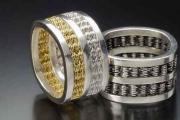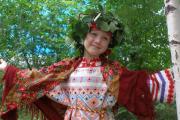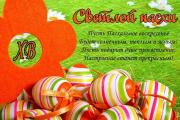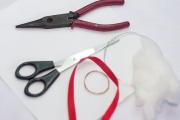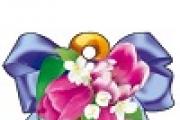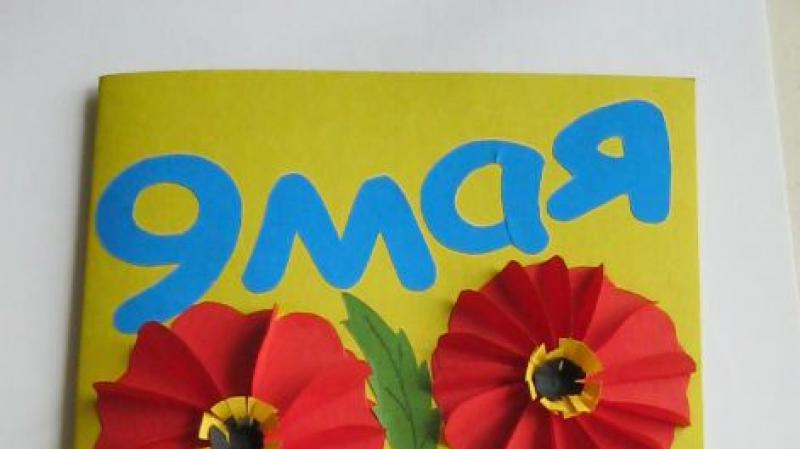How to weave a snowflake from beads. Creating Christmas decorations in the form of snowflakes
Beaded snowflakes on the branches of a Christmas tree look charming and delicate! And how magically they play against the background of the garland lanterns! If you like this effect, then this article is for you! Decorate your tree as you please! Imagine and invent!
Today we want to show you beaded snowflake patterns. We will prepare with might and main for the New Year in advance, so as not to get into a mess on the eve of the event.

What is needed to weave snowflakes:
- multicolored small beads
- bugles
- medium faceted beads
- small faceted beads
- small beads
- fishing line
It is better to string snowflakes on a wire so that the product keeps its shape. Use beads of light blue, blue, white, silver and other shades. To weave snowflakes with your own hands, carefully study the weaving patterns and examples of finished products. You can always change something in the pattern and weave your own unique snowflake and decorate the Christmas tree with it. Also, these snowflakes can be used as a keychain, souvenir and gift. Very varied and beautiful shapes snowflakes will surprise and delight the whole family for the holiday.



Beaded snowflake patterns: decorating an apartment with our own hands










































Several detailed workshops of beaded snowflakes
Flat snowflakes
Snowflake number 1
The snowflake is made of gold and pearl pink beads with a diameter of 4 mm. Carry out the product in accordance with fig. 21. When weaving the last rows of snowflakes, you can use a needle, since the hole in the beads is quite large. Make sure that the wire does not twist, as this will form small knots and the wire breaks easily in these places. It is advisable to go through the last row twice so that the product is sufficiently rigid and keeps its shape. When finished, the snowflake has a diameter of just over 7 cm. You can also use fishing line for weaving.

At the end, pass a gold thread through any extreme gold bead, tie a small knot, after which the snowflake can be hung on the tree.
1st row cast on 16 beads alternating gold and pink beads through one. Close the beads into a ring (Fig. 21, a).
2nd row - consists of 8 beams, 3 beads of gold color in each beam (Fig. 21, b, c, d).
3rd row - also consists of 8 rays and in each of 5 pink and 3 gold beads, forming a picot (Fig. 21, e, f, g, i, i).
4th row - just like the second row, it consists of 8 rays but 3 gold beads in each (Fig. 22, k-l).
Snowflake number 2
This snowflake is made of gold beads with a diameter of 4 mm and 2 mm and pearl pink beads with a diameter of 4 mm. How to make a snowflake is shown in fig. 22. When finished, this product has a diameter of 9 cm.

1st row - dial 4 gold beads and close them in a ring (Fig. 23, a, b).
2nd row consists of 4 beads color pink(Fig. 24, a, 6).
The 3rd row has 4 rays, each of which consists of 5 pink beads (Fig. 25, a-c).
The 4th row also consists of 4 rays of 3 gold beads each (Fig. 26, a. B).
The 5th row is formed by eight rays, each of which has a picot of three large beads and three small beads. In this? / 1 row, all the beads are gold (Fig. 27, a-f).
The 6th row has 8 rays of 3 pink beads each (Fig. 28, a-c).
Winter snowflake
This snowflake is made of white shiny bugles, white mother-of-pearl beads with a diameter of 2 and 4 mm, and white mother-of-pearl beads. It is desirable to choose a white wire.
Weaving in a cross is the basis for weaving this snowflake.

1st row- take 14 beads with a diameter of 2 mm and 14 beads and weave a chain as shown in fig. 51. Close the chain into a ring by crossing both ends of the wire in the first bead (Fig. 52, a).
The ring should lie in the plane of the table.
Each new row is woven with a new wire with two working ends. At the end of each row, carefully hide the ends of the wire. For those who have mastered the basics of this method, you can weave all the chains with one wire with two ends, transferring them from row to row (Fig. 52, 6).

2nd row- type a bugle and a bead on the right end of the wire (P), with the left end go through the bead of the first row and string the bugle, in which you cross both ends of the wire. For those who continue to weave with one wire from row to row, string bugles and beads on the right end of the wire, and only bugles on the left (JI) and also cross the ends in it (Fig. 52, c). Then string one bead on the right end of the wire, and on the left bugle beads (Fig. 52, d). Pass the right end through the bugles located on the left end of the wire. In this row, bugles are the connecting link where both ends of the wire are crossed. Now pass the left end of the wire through the beads of the first row and string the bugles; string the beads on the right end (Fig. 52, e). Continue working, guided by Figures 52, e.
3rd row- string bugles and a bead with a diameter of 2 mm on the wire, pass the left end of the wire through the beads of the second row (Fig. 53, a), string bugles on one end of the wire and cross both ends in it. Continue working, guided by Figures 53 (b-e). Until the end of the row, you pick a bead on the right end of the wire, and with the left one pass through the bead of the second row, cross both ends in a bugle, which is a connecting link. At the end of the work, carefully hide both ends of the wire, but only if "you use a new piece of wire for each subsequent row."
Each row of snowflakes must lie in the plane of the table.
4th row- string bugles on the wire, one small bead, one large, 4 mm in diameter and again one small (Fig. 54, a), with the left end of the wire go through the small bead of the third row and string the bugles on the left end (Fig. 54, b) in which cross both ends of the wire. Now type one small bead on the right end of the wire, and with the left go through the bead of the third row (Fig. 54, c). Cross both ends of the wire in glass beads (Fig. 54, d) and string one small and one large bead on the right end of the wire, then again one small, with the left end of the wire go through the bead of the third row and cross both ends of the wire in glass beads again. Continue with fig. 54, a-e.
At the end of the row, carefully hide the ends of the wire, this also applies to those who weave all rows with one wire.
5th row consists of 7 petals, each of which is braided separately. To weave one petal, take a piece of wire and thread it through 3 small beads, as shown in fig. 55, a.
Weaving is also done at two ends. String bugles on the right end of the wire and cross both ends of the weeding in it (Fig. 55, b).

Then type one small bead on the right end, and one bead on the left, cross both ends of the wire in bugles (Fig. 55, c).
Continue to weave and each time type a small bead on the left end, and a small bead on the right, the connecting link, as before, will be a bugle, in which both ends of the wire cross. When there are five such links, put one bead on the left end of the wire, and make a picot on the right of the four large beads (Fig. 55, d).
Then cross both ends of the wire in the glass beads. Proceed as shown in fig. 55, e, f. As soon as you cross both ends of the wire in the 10th bugle, if you count from the beginning of the weaving of the petal, pass both ends of the wire through 3 small beads towards each other (Fig. 55, g). With the end that will be closer to the middle of the petal, go through all 9 beads inside the petal (Fig. 56). Next, pass the same end of the wire through the adjacent 3 small beads and draw both ends of the wire towards each other from the edge of the snowflake to its middle.
Then cut off the excess wire (fig. 57). All subsequent petals are woven in the same way.
In fig. 58, a. 6 shows options for weaving petals, which will give you the opportunity to weave several more new ones based on the above snowflake.
Winter has already come into its own with might and main, so today we will make another winter-themed product - a snowflake.
For her we need:
- bugles of size No. 3; I took a blue bugle;
- beads of size No. 10; I took beads of light green color with a pearlescent tint;
- beads of size No. 8 (you can take even larger beads); I took blue beads;
- wire with a diameter of 0.3 mm.
So, let's go directly to the master class. First, we make the middle part of the snowflake.
We take a wire 160 cm long, put on it one large bead and four pieces of glass beads and place the set on the wire so that the tip of the wire about 10-15 cm long remains on the side of the glass beads.
Take the short end of the wire and pass it through the bead from the side of the other end of the wire.
We tighten the wire, trying to keep the short end of the wire about 10 cm long. We have a bugle loop with a bead at the base.
All further weaving is carried out only on long end wire. We no longer need the short end of the wire; we will fasten and cut it at the end of the weave.
and pass the wire through the nearest lower piece of bugle from the previous loop from top to bottom (that is, to the base of the loop) and then immediately - through the bead from our last set.
We tighten the wire - next to the first loop of glass beads, a second loop is obtained.
Further, in the same way, we weave three more loops, so that a total of five such loops are obtained. Let me remind you that for each loop we collect one large bead and three pieces of glass beads.
We connect the loops in a circle. To do this, first we collect one large bead on the wire
and we pass the wire through the nearest lower piece of glass beads from the very first loop from bottom to top (that is, from the base of the loop to the outside).
Then we collect two pieces of glass beads on the wire
and pass it through the nearest lower piece of bugle from the last woven loop from top to bottom (that is, to the base of the loop) and then immediately through two beads: the last dialed bead and the bead from the very first loop.
We tighten the wire - we have got the middle part of the snowflake, consisting of six loops woven in a circle.
Next, weave the rays of the snowflake. Before that, we pass the wire through the nearest piece of glass beads, that is, we bring it to the outer border of the middle part of the snowflake.
First we weave a small ray. Let's break its weaving into 3 steps.
Step 1. Put on the wire two pieces of glass beads and one small bead
then, holding this bead, we pass the wire in the opposite direction through the segment of glass beads closest to it.
We push the set close to the product and tighten the wire.
Step 2. We collect one piece of glass beads and one small bead on the wire.
Again we hold the bead and pass the wire in the opposite direction through the piece of glass beads.
We push the set close to the previous one and tighten the wire. We straighten two pieces of glass beads with beads so that they look in different directions from the very first piece of glass beads in this ray.
Step 3. For this ray of snowflakes, we just need to make a tip, and then bring the wire to the base of the ray. We put on the wire one piece of glass beads and one small bead,
hold the bead and pass the wire in the opposite direction through a piece of glass beads from the last set, after which we immediately pass the wire through the very first piece of glass beads in this beam.
Gently pull out the wire - the first ray of the snowflake is ready.
To continue weaving, we pass the wire through the nearest piece of glass beads, located along the perimeter of the middle part of the snowflake,
and then we begin to weave the second ray of the snowflake. This ray is made in the same way as the first, only it will be larger in size. We start weaving in the same way as in the case of the small ray - we carry out the first two steps. We have got the first tier of a large ray.
Then we repeat the first two steps again to get the second tier of the large ray - exactly the same as the first.
It remains for us to make a tip for this ray, and then bring the wire to the base of the ray. We apply the same technique as in the 3rd step when weaving a small ray: we collect one piece of glass beads and one small bead on the wire,
hold the bead and pass the wire in the opposite direction through a piece of glass beads from the last set, after which we immediately pass the wire sequentially through two pieces of glass beads that make up the axis of the given ray of the snowflake.
Gently pull out the wire - the second ray of the snowflake is ready.
Again, to continue weaving, we pass the wire through the nearest piece of glass beads, located along the perimeter of the middle part of the snowflake, in the direction of its free part.
Several workshops on weaving snowflakes. Making snowflakes different types, as well as using beads and bugles for them different colors You can create a real fairytale blizzard!
P.S. Would you like to miss our new master classes?
Greetings, Dear friends! Today we will tell you how to weave a snowflake from beads with your own hands. In one of the Japanese magazines, we found and translated for you a master class with a pattern for weaving snowflakes from beads. It will be a great decoration for Christmas tree or a gift decoration element.
Tools and materials Time: 45 minutes Difficulty: 3/10
- 4mm bicone crystals;
- any beads;
- line for beads;
- beading needle.
Step-by-step weaving instructions

Step 1: starting work from the center
Weaving goes in two strands, so we cut off a larger piece of fishing line, and start working from the center of this very segment.

First of all, we string 5 beads on the fishing line, and cross both tails in the sixth. So we form the base of the inner circle, to which the rays will be woven.
Step 2: weave bicones

Step 3: shape the petals
To form the second petal of the circle, string five beads on the tail that comes out of the bicone from above, and send the lower tail through the bead of the first circle, and then cross both threads in the next threaded bicone. The lower tail is sent again through the next bead of the small circle.


Thus, we continue to weave in a circle until we fill it completely with the petals.

Step 4: weaving rays
In order to form the first ray of a snowflake, it is necessary to weave three rows with a cross. To do this, string one bead on each tail, and cross them in the next stringed bead. We do this three times.

We go through the beads of the last cross in the opposite direction so that each tail ends up in the outermost beads of the second cross (each on its own side). We form one cross on each side.


The ponytails pass through the side beads of the first cross, from they go to the place where the second ray is formed.


Thus, in the end, we get only 6 rays, for one of which the product can be fixed on a chain or special accessories for a keychain.

1. Making a snowflake from beads and bugles.
New Year is a wonderful holiday! Both adults and children are looking forward to it. We all want to decorate our home in the most beautiful and unusual way. I bring to your attention a master class on step-by-step manufacturing snowflakes made of beads and bugles. Such snowflakes will certainly add magic and a sense of celebration.
So let's get started!
To make such a snowflake we need:
- - wire 0.24-0.25 thick;
- - beads 6 mm;
- - beads 4 mm;
- - beads 3 mm;
- - glass beads 12 mm.
We cut off a wire one meter long, bend it at the tail so that our beads do not roll.
We collect the beads in the following order: one bead 6 mm, one bead 3 mm, and so on until we have 16 beads on the wire (8 beads 6 mm and 8 beads 3 mm).
We close it in a ring.
The long end of the wire should protrude from the 6 mm bead.
On it we string two beads of 3 mm, one bead of 4 mm and again two beads of 3 mm.
We put the end of the wire back into a 6 mm bead, pass it through a 3 mm bead and put it back into a 6 mm bead.
When I reach the short "tail", I twist the wire. Thus, securing the circle.
We weave the whole circle. We put the wire into a 4 mm bead.
Now we will make "bridges" between our arcs. To do this, select 5 beads of 3 mm and connect our tops through beads of 4 mm.
We lead the wire through the third bead of our "bridge". We collect beads in the following order:
- - 4 mm - 1 piece;
- - bugles - 1 piece;
- - 3 mm - 1 piece;
- - 4 mm - 1 piece;
- - 3 mm - 3 pcs.
We return the wire to the 4 mm bead, thereby forming the tip.
We again put a 3 mm bead, glass beads, 6 mm bead on the wire. We thread the tail into the third bead of our "bridge". We repeat in the same way seven more times. Tangle the wire in weaving and cut it off.
That's it, the snowflake is ready!
According to this pattern, you can weave absolutely different snowflakes, you just have to turn on the fantasy! Replace the beads with bugles, change the colors of the beads, and here is a completely new snowflake!
Don't be afraid to experiment! Good luck with your creativity and Happy New Year!
2. Snowflakes made from red beads
Weaving patterns:
Weaving patterns:
3. Winter snowflake
This snowflake is made of white shiny bugles, white mother-of-pearl beads with a diameter of 2 and 4 mm, and white mother-of-pearl beads. It is desirable to choose a white wire.
Weaving in a cross is the basis for weaving this snowflake.
1st row - take 14 beads with a diameter of 2 mm and 14 beads and weave a chain as shown in fig. 51. Close the chain into a ring by crossing both ends of the wire in the first bead (Fig. 52, a).
The ring should lie in the plane of the table.
Each new row is woven with a new wire with two working ends. At the end of each row, carefully hide the ends of the wire. For those who have mastered the basics of this method, you can weave all the chains with one wire with two ends, transferring them from row to row (Fig. 52, 6).
2nd row - type bugles and a bead on the right end of the wire (P), with the left end go through the bead of the first row and string the bugle, in which you cross both ends of the wire. For those who continue to weave with one wire from row to row, string bugles and beads on the right end of the wire, and only bugles on the left (JI) and also cross the ends in it (Fig. 52, c). Then string one bead on the right end of the wire, and on the left bugle beads (Fig. 52, d). Pass the right end through the bugles located on the left end of the wire. In this row, bugles are the connecting link where both ends of the wire are crossed. Now pass the left end of the wire through the beads of the first row and string the bugles, string the beads on the right end (Fig. 52, e). Continue working, guided by Figures 52, e.
3rd row - string bugles and a bead with a diameter of 2 mm on the wire, pass the left end of the wire through the beads of the second row (Fig. 53, a), string bugles on one end of the wire and cross both ends in it. Continue working, guided by Figures 53 (b-e). Until the end of the row, you pick a bead on the right end of the wire, and with the left one pass through the bead of the second row, cross both ends in a bugle, which is a connecting link. When finished, carefully hide both ends of the wire, but only if "you use a new piece of wire for each subsequent row."
Each row of snowflakes must necessarily lie in the plane of the table.
4th row - string bugles on the wire, one small bead, one large, 4 mm in diameter and again one small (Fig. 54, a), with the left end of the wire go through a small bead of the third row and string bugles on the left end (Fig. 54, b), in which cross both ends of the wire. Now cast on the right end of the wire one small bead, and with the left go through the bead of the third row (Fig. 54, c). Cross both ends of the wire in glass beads (Fig. 54, d) and string one small and one large bead on the right end of the wire, then again one small one, with the left end of the wire go through the bead of the third row and cross both ends of the wire in glass beads again. Continue with fig. 54, a — e.
At the end of the row, carefully hide the ends of the wire, this also applies to those who weave all rows with one wire.
The 5th row consists of 7 petals, each of which is braided separately. To weave one petal, take a piece of wire and thread it through 3 small beads, as shown in fig. 55, a.
Weaving is also done at two ends. String bugles on the right end of the wire and cross both ends of the weeding in it (Fig. 55, b).
Then type one small bead on the right end, and one bead on the left, cross both ends of the wire in bugles (Fig. 55, c).
Continue to weave and each time type a small bead on the left end, and a small bead on the right, the connecting link, as before, will be a bugle, in which both ends of the wire cross. When there are five such links, put one bead on the left end of the wire, and make a picot on the right of four large beads (Fig. 55, d).
Then cross both ends of the wire in the glass beads. Proceed as shown in fig. 55, e, f. As soon as you cross both ends of the wire in the 10th bugle, if you count from the beginning of the weaving of the petal, pass both ends of the wire through 3 small beads towards each other (Fig. 55, g). With the end that will be closer to the middle of the petal, go through all 9 beads inside the petal (Fig. 56). Next, pass the same end of the wire through the adjacent 3 small beads and draw both ends of the wire towards each other from the edge of the snowflake to its middle.
Then cut off the excess wire (fig. 57). All subsequent petals are woven in the same way.
In fig. 58, a. 6 shows options for weaving petals, which will give you the opportunity to weave several more new ones based on the above snowflake.
Beautiful graceful snowflakes made of beads and beads are a great option for decorating the interior during the New Year and Christmas holidays. The scheme for creating such a festive attribute is usually not complicated. Use the master class, video explainer, to make your own little piece of winter that will never melt.
Necessary materials for weaving:
- beads (beads) of a suitable color;
- wire for beading.
The bead snowflake master class begins with the preparation of a wire piece 1.5 m long. Next, we need to collect one bead and place it next to the edge, as in the photo.
 The short tip must be passed through this bead in the opposite direction and pulled together.
The short tip must be passed through this bead in the opposite direction and pulled together.
Scheme of the next stage: we collect five pieces of beads or beads and, holding them, we collect twelve more. After that, we pass the wire in the opposite direction through the twelfth. We pull together the weaving and get a loop.
We begin to make the second loop, which will be located side by side. For this we collect twelve beads (beads) and thread the tip into the twelfth in the opposite direction and again tighten the weaving. Follow the process of creating a snowflake using photo materials that reflect all the beading. The scheme of actions will be repeated from stage to stage.
 Now, we collect five pieces of beads or beads, while holding them, add twelve more and thread the wire in the opposite direction through the twelfth. We tighten the weaving.
Now, we collect five pieces of beads or beads, while holding them, add twelve more and thread the wire in the opposite direction through the twelfth. We tighten the weaving.
We will make a similar loop in a row from the set of twelve beads, after which we pass the end in the opposite direction through the last one and tighten it.
 Next, you need to make another row with similar loops. At the end of the third row, we create the last loop of 12 pieces, threading the wire in the opposite direction through the last one, completing the beading by pulling it together.
Next, you need to make another row with similar loops. At the end of the third row, we create the last loop of 12 pieces, threading the wire in the opposite direction through the last one, completing the beading by pulling it together.
 To continue weaving, draw a segment into the initial bead, passing it through all those in the middle. As a result, both ends should come out of one.
To continue weaving, draw a segment into the initial bead, passing it through all those in the middle. As a result, both ends should come out of one.
Further, the master class proceeds with the manufacture of the next branch. We collect six pieces of the main material and hold them after another twelve. We pass the wire in the opposite direction to the twelfth according to the technology already familiar to us.
 We form the second loop from twelve pieces, continuing to do the same actions.
We form the second loop from twelve pieces, continuing to do the same actions.
 Then, we type five, hold them, add 12 more and repeat the manipulations again. It remains to make a second loop of 12 pieces.
Then, we type five, hold them, add 12 more and repeat the manipulations again. It remains to make a second loop of 12 pieces.
In the same way, we make the next row, the third in a row, and create the last loop on the first of the branches. We pass a segment through all the beads in the middle and get two branches.
 We make six such branches, and we master the rest according to the scheme of the second branch.
We make six such branches, and we master the rest according to the scheme of the second branch.
 Having finished the beading, unravel the loop that was made on the initial bead and twist the ends together.
Having finished the beading, unravel the loop that was made on the initial bead and twist the ends together.
 It remains to cut the wire or leave the resulting loop so that the snowflake made of beads for beginners can decorate the Christmas tree.
It remains to cut the wire or leave the resulting loop so that the snowflake made of beads for beginners can decorate the Christmas tree.
 Such light scheme and step by step master class will allow you to easily create multi-colored snowflakes from beads with your own hands. In addition to photos, use video materials with step-by-step display of actions.
Such light scheme and step by step master class will allow you to easily create multi-colored snowflakes from beads with your own hands. In addition to photos, use video materials with step-by-step display of actions.
Consider a master class for weaving a snowflake with six faces, which is based on the principle of creating ray lines connected into one whole.
Materials:
- bugles;
- light beads (beads);
- wire.
Cut off thirty-two centimeters from the wire and place four units of glass beads in the center, from which you need to make a rhombus, as in the photo.
 On each of the ends we string 2 bugles and bend the wire in such a way as shown in the photo:
On each of the ends we string 2 bugles and bend the wire in such a way as shown in the photo:
 We again string the bugles on each segment, twist and thread it through the previous bugle forward and twist again. We get a rhombus with "tails":
We again string the bugles on each segment, twist and thread it through the previous bugle forward and twist again. We get a rhombus with "tails":
 Weave the next two "tails" from the smaller bugle. The wire must be threaded and wound between the tails. Cut off the unnecessary and bend the tip to the bugle.
Weave the next two "tails" from the smaller bugle. The wire must be threaded and wound between the tails. Cut off the unnecessary and bend the tip to the bugle.
 We make 5 similar elements in total. After that, we connect the two adjacent elements, passing the segment through the bugle of the initial rhombus located at the bottom.
We make 5 similar elements in total. After that, we connect the two adjacent elements, passing the segment through the bugle of the initial rhombus located at the bottom.
 We string three beads onto the twisted wire and twist them too. Cut off the excess and hide the end.
We string three beads onto the twisted wire and twist them too. Cut off the excess and hide the end.
 To give the snowflake solidity, you can intertwine its central part with a wire section with strung beads, adding another one to the very center.
To give the snowflake solidity, you can intertwine its central part with a wire section with strung beads, adding another one to the very center.


Schemes for creating snowflakes
You can try to learn how to weave snowflakes from beads or beads, focusing on the diagrams and video tutorials. Intuition can tell you what to do and how to do it.
Circular weaving patterns:




